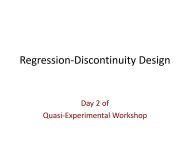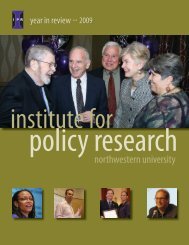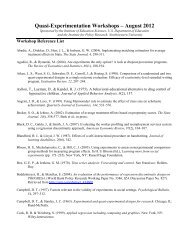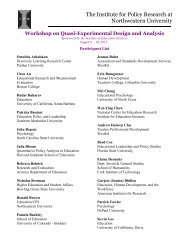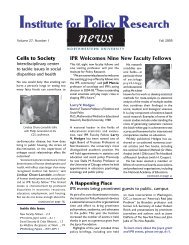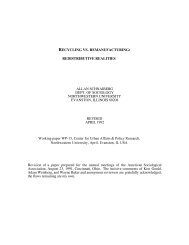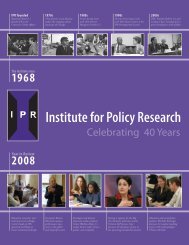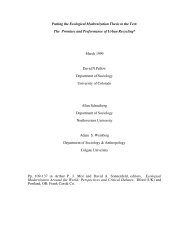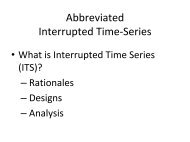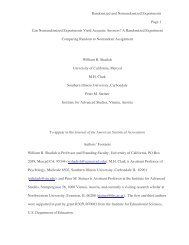pdf - Institute for Policy Research - Northwestern University
pdf - Institute for Policy Research - Northwestern University
pdf - Institute for Policy Research - Northwestern University
Create successful ePaper yourself
Turn your PDF publications into a flip-book with our unique Google optimized e-Paper software.
P. Reese<br />
Project CeaseFire<br />
Chicago perpetually ranks as one of the<br />
nation’s leading cities <strong>for</strong> homicide.<br />
Project CeaseFire, an initiative of the<br />
Chicago Project <strong>for</strong> Violence Prevention<br />
(CPVP), aims to address this issue<br />
by reducing all <strong>for</strong>ms of violence in<br />
targeted areas in Chicago and the state.<br />
The program has five core components:<br />
client outreach, community mobilization,<br />
law en<strong>for</strong>cement collaboration, clergy<br />
intervention, and public education. How<br />
effective can a broad-based community<br />
partnership like the CPVP be in reducing<br />
violent crime and deadly hand-gun use?<br />
The National <strong>Institute</strong> of Justice awarded<br />
Skogan and his team a grant to study this<br />
question.<br />
The first phase of the project involved<br />
fieldwork, personal interviews, and<br />
surveys to outline the entire program<br />
and to evaluate 20 northern Illinois<br />
CeaseFire projects and their relationship<br />
to headquarters. In the second phase,<br />
researchers are examining the impact the<br />
program is having on violence through<br />
an area-level study of trends in violent<br />
crime.<br />
Using statistical network analysis and<br />
ethnographic fieldwork, they are tracing<br />
the program’s effects on local gang<br />
dynamics. In addition to studies of local<br />
clergy, clients, and CeaseFire staff, Skogan<br />
and his colleagues are collecting data to<br />
map gang activity and analyze case studies<br />
of school violence. A Violence Interrupter<br />
Study and a Community Partner Study<br />
will also contribute to the final report,<br />
to be released in 2008. The report will<br />
also address the cost effectiveness of such<br />
violence prevention programs.<br />
Chicago Alternative Policing Strategy<br />
Program (CAPS)<br />
It has been more than a decade since the<br />
Chicago Alternative Policing Strategy<br />
program (CAPS), the nation’s largest<br />
experiment in community policing, was<br />
started. Skogan and his research team<br />
have been evaluating the program since<br />
1993.<br />
CAPS involves the creation of tur<strong>for</strong>iented<br />
teams of police officers<br />
with long-term beat assignments,<br />
extensive community involvement and<br />
empowerment, and integration with<br />
improved city services. The program<br />
encourages police and residents to engage<br />
in neighborhood problem solving.<br />
Skogan’s latest<br />
book, Police and<br />
Community in<br />
Chicago: A Tale<br />
of Three Cities<br />
(Ox<strong>for</strong>d <strong>University</strong><br />
Press), traces the<br />
varying impact<br />
that CAPS had<br />
on Chicago’s<br />
neighborhoods.<br />
Based on the evaluation’s<br />
yearly<br />
Chicago Police Department.<br />
Wesley Skogan talks with members of the<br />
tracking polls,<br />
many of the city’s communities grew<br />
significantly safer, more orderly, and<br />
cleaner during the 1990s and early 2000s.<br />
Yet after 10 years, benefits of the program<br />
seemed to fall unevenly between African<br />
Americans, whites, and Latinos, Skogan<br />
finds. The Academy of Criminal Justice<br />
Sciences named it its Outstanding Book<br />
of the Year <strong>for</strong> 2006.<br />
In the book, Skogan pointed out that<br />
overall crime rates have dropped,<br />
particularly in African American<br />
communities, and satisfaction with the<br />
quality of police service is up across all<br />
demographic groups. Eighty percent of all<br />
Chicagoans—and almost 90 percent of<br />
African Americans—are familiar with the<br />
program, and in 2002, more than 67,000<br />
people attended the monthly public<br />
meetings held by every police beat.<br />
www.northwestern.edu/ipr 23



